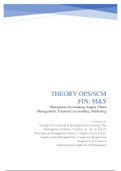Summary
Summary Theory: OPS/SCM; FIN; M&S Exam
- Course
- Institution
- Book
This is a fully written summary of the Exam: Theory: OPS/SCM; FIN; M&S, at The Hanze University of Applied Sciences. The books which were used to make this summary include: Horngren’s Financial & Managerial Accounting: The Managerial Chapters: Chapter 16, 18, 22, 23 Principles of Managerial Fina...
[Show more]




